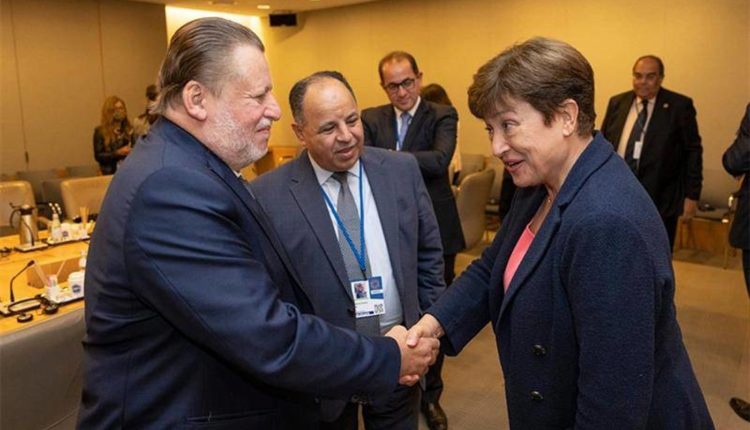Key Questions on Egypt
- WHAT ARE THE MAIN ELEMENTS OF THE IMF SUPPORTED PROGRAM WITH EGYPT?
- WHY IS EXCHANGE RATE FLEXIBILITY IMPORTANT FOR EGYPT?
- EGYPT FACES A LARGE EXTERNAL FINANCING GAP. HOW WILL IT BE FILLED?
- HOW DOES THE PROGRAM PROTECT EGYPT’S VULNERABLE HOUSEHOLDS?
- WHAT MEASURES IN THE PROGRAM SUPPORT DEVELOPMENT OF THE PRIVATE SECTOR?
- HOW IS THE CONFLICT IN GAZA AND ISRAEL AND DISRUPTIONS IN THE RED SEA AFFECTING EGYPT?
- WHAT IS THE POTENTIAL IMPACT OF THE DEBT ON THE STATE BUDGET?
- HOW DOES THE RAS EL-HEKMA INVESTMENT DEAL IMPACT THE IMF-SUPPORTED PROGRAM WITH EGYPT?
- WHAT IS THE IMF DOING TO PROMOTE GREATER TRANSPARENCY OVER POLICIES IN EGYPT?
hat are the main elements of the IMF supported program with Egypt?
The Egyptian economy faces significant macroeconomic challenges that have become more complex to manage with the recent conflict in Gaza and Israel. At the same time, the UAE’s recent investment deal has relieved the near-term pressures and provides a unique opportunity to address these challenges successfully. The IMF supported program with Egypt, which was approved last year, remains centered on four key goals to ensure macroeconomic stability and secure private-sector-led growth:
- A shift to a flexible exchange rate system that will help Egypt’s domestic economy adjust more smoothly to external shocks, support the ability of Egyptian businesses to sell their goods and services abroad, and encourage greater investment.
- Monetary and fiscal policy tightening, including through containing off-budget capital expenditure, are needed to reduce inflation and maintain debt sustainability. Managing large capital inflows prudently will be important to contain inflationary pressures and limit future external vulnerabilities.
- In recognition of the significant adverse impact high inflation has on purchasing power, targeted budget support to vulnerable households is warranted and budget space for such support needs to be protected.
- Better balancing the roles of the public and private sectors, with a focus on enhancing competition and allowing a greater role for the private sector in driving growth.
Why is exchange rate flexibility important for Egypt?
• In the past, a heavily managed exchange rate has not served the Egyptian people well. It has led to periods of building imbalances, lack of foreign currency, rationing, and sudden drops in the value of the Egyptian pound. These abrupt devaluations have led to spikes in inflation and undermined economic activity, as investor confidence has been dented.
• The objective under the Fund-supported program is, therefore, to shift to a flexible exchange rate regime whereby the value of the Egyptian pound would be determined freely against other currencies. Under this framework, one would observe two-way movements in the exchange rate, as it appreciates or depreciates smoothly in line with economic conditions. The first step in this direction is to have a unified exchange rate and make foreign exchange (FX) available to everybody at the same exchange rate.
• Flexibility in the exchange rate would bring several benefits. It would help Egypt’s domestic economy adjust more smoothly to external shocks, support the ability of Egyptian businesses to sell their goods and services abroad, and encourage greater investment by reducing the likelihood of large abrupt changes in the exchange rate. In addition, it would help preserve the financial buffers of the central bank.
Egypt faces a large external financing gap. How will it be filled?
The external financing gap represents the difference between the projected demand for and supply of foreign currency financing, including the demand for foreign currency to rebuild the foreign reserves of the central bank. IMF financial support under the program will fill part of the financing gap. In addition, an important objective of IMF-supported programs is to catalyze broader financial support from international and bilateral partners, as well as private sector investors. Commitments secured from foreign partners and the continued rollout of the asset divestment program help to close the financing gap over the program period. In this context, the $24 billion of from the Ras El-Hekma investment deal is welcome and the Central Bank of Egypt (CBE) has committed to capture the bulk of it to build its international reserves. In addition, the conversion of the $11 billion UAE deposits at the CBE into Egyptian Pound denominated deposits will improve the composition of the CBE’s reserves.
How does the program protect Egypt’s vulnerable households?
Safeguarding macroeconomic stability and fighting inflation are key to ensuring prosperity for all Egyptians, particularly the most vulnerable. In this regard, monetary policy under the program is focused on bringing down inflation and stemming the erosion in purchasing power that is disproportionately affecting poor and middle-class families. Given the significant impact of high inflation on the purchasing power of low- and middle-income households, expanding targeted budget support to vulnerable households is warranted and budget space for such support needs to be protected. In this regard, coverage of the Takaful and Karama cash transfer program has been expanded to cover more than 5 million households and the authorities announced a broad EGP180 billion social protection package in early-2024, which included an increase in the public sector minimum wage and specific support to teachers and healthcare workers. Over the medium term, progress on a wide-ranging structural reform agenda will help Egypt achieve higher, sustainable, and more inclusive, private-sector-led growth.
What measures in the program support development of the private sector?
The continued implementation of the State-Ownership Policy and rollout of the asset divestment program will play a critical role in reducing the state footprint and strengthening the ability of the private sector to better contribute to economic growth in Egypt. Complementing this, efforts to strengthen the independence of the Egyptian Competition Authority, streamline procedures companies face when investing in Egypt, and to further improve governance and anticorruption measures will be important in creating an attractive business environment that supports growth.
How is the conflict in Gaza and Israel and disruptions in the Red Sea affecting Egypt?
- Both tourism and Suez Canal receipts are important sources of foreign exchange for Egypt. Tourism receipts reached US$13.6bn during FY 2022/23 and Suez Canal current account receipts averaged over US$700 million per month.
- Despite some moderation, tourism is holding up reasonably well in challenging circumstances, with bookings at similar levels to a year ago.
- However Red Sea disruptions are impacting FX flows, could deter tourism, and through their impact on trade could result in shortages and add to inflationary pressures. Suez Canal receipts declined by almost half in January 2024 relative to January 2023.
What is the potential impact of the debt on the state budget?
- The economic strategy under the program is focused on reducing Egypt’s debt by putting the general government debt-to-GDP ratio on a downward path. This is expected to be achieved through continued fiscal discipline, while ensuring adequate social protection spending, and use of divestment proceeds.
- More revenue mobilization will be key to help support this effort as it will help creating space for priority spending and for targeted support for the vulnerable. Proceeds from the ongoing state asset divestment program will help reduce public debt further.
How does the Ras El-Hekma investment deal impact the IMF-supported program with Egypt?
What is the IMF doing to promote greater transparency over policies in Egypt?
The IMF-supported program has a number of measures to promote greater fiscal transparency. Transparency helps governments obtain an accurate picture of their finances when making economic decisions, including of the costs and benefits of policy changes and potential risks to public finances. It also provides legislatures, markets, and the public with the information they need to hold governments accountable. Greater fiscal transparency can also help strengthen the credibility of a country’s fiscal plans and can help underpin market confidence and market perceptions of fiscal solvency. The authorities have committed to a significant number of concrete measures in this area, including:
• Significant steps to better monitor and control on-and off-budget public sector investment. The Prime Minister has issued a decree that requires all public entities to report annual projected and executed investment spending and specifies target ceilings on the value of total public investment that will be monitored under the program through an indicative target.
• Introducing a binding requirement to ensure the timely publication of audit reports on fiscal accounts by the Central Auditing Organization (CAO);
• Publication of all public procurement contracts that exceed EGP 20 million on the procurement portal website, also available here;
• Publication of all procurement contracts and awards made by the largest 50 state-owned enterprises on the procurement portal website;
• Publication of a comprehensive annual tax expenditure report including details and estimates of tax exemptions and tax breaks;
• Publication of reports on payment arrears by the Ministry of Finance.











